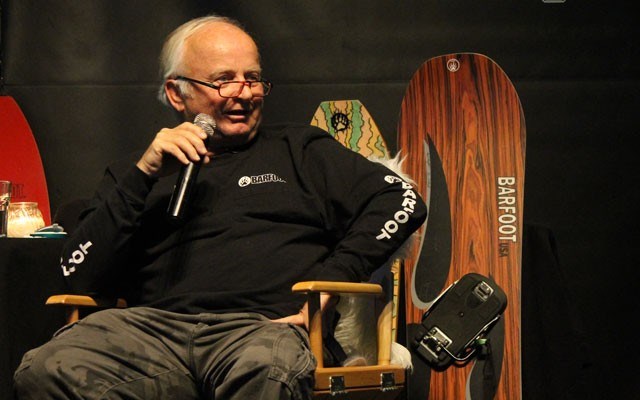With his affable, easygoing demeanour, it's easy to listen to Chuck Barfoot describe how snowboarders were first allowed to use chairlifts at his local hill in California.
Invited to the Garibaldi Lift Co. as the sophomore speaker in the Mountain Story series with interviewer Naheed Henderson, the Barfoot Snowboards founder — credited with developing the twin-tip board — described the tensions between the entrenched skiing crowd and the brand-new boarders at Mountain High Resort. It didn't take a rally, sit-in or petition, no civil disobedience of any kind to get on the hill.
Rather, one of the major milestones on snowboarding's trek into the mainstream, at least in Barfoot's neck of the woods, ended up being the reversal of a bad business decision.
Barfoot said boarders initially hoped to hit up the Mountain High Resort, just northeast of Los Angeles, but were rebuffed. He recalled the manager calling their boards — which were great for powder but flimsy for riding hard pack — "toys" and not allowing them on the hill. No matter, he explained. There was a smaller two-chair park called Ski Sunrise across the street.
"Come springtime, we're looking at Mountain High," he said, and, "It was wet snow, which sucked for skiers. There were no skiers on the mountain at all. The lifts are all running just chewing up money. The only cars in the parking lot were the guys running the lifts.
"We're over at Ski Sunrise. I've got 125 guys riding at Ski Sunrise across the street and the (Mountain High) manager, I'll never forget, comes up sweating... he's standing in the parking lot with his arms crossed and he recognized me.
"He goes 'I think I was wrong' and I go 'Oh yeah.' So the next year, they allowed us on Mountain High."
Even after gaining entry, snowboarders were "on probation" for the first two years. Barfoot did his best to make sure the transition ran smoothly, even after one overzealous ski patroller reported him when he was riding safely. Still, with skateboard counterculture coming to the mountains, he knew there was plenty of work to be done to ensure a productive relationship.
"Skiers didn't like snowboarders, and snowboarders were skate punks with shit attitudes," he said. "I had guys kicked off the mountain because they were being jackasses.
"They finally got it."
Barfoot, who originates from New Jersey, said his interest in snowboarding came from surfing, so much so that some of his early designs included fins, as they mimicked surfboards in the early going. His first designs were built before he went snowboarding for the first time and were "absolutely freakin' horrible."
"I had been building surfboards," he said. "I had been building skateboards, so I had the designs in my head.
"I had a design in my head which came from surfing and I knew I could design something that was on snow.
"I didn't know how much I was going to love it, but after the first ride, it was the same feeling I had after the first time I surfed. This is unbelievable."
Early on, Barfoot worked with Tom Sims for nearly a decade before an acrimonious split led Barfoot to venture out on his own. They briefly ran Sims Skateboards and Barfoot Snowboards before Barfoot sensed he was being nudged aside.
Barfoot found success on his own, but stopped building boards a dozen years ago after becoming disillusioned with the industry. For several years he just built boards for himself and a few select friends before halting completely.
"If you go some place with a few friends and ride and just have a great day, that's what it's all about," he said.
"I just couldn't do it anymore. I was angry all the time and I was wondering 'What the hell's wrong with me? I'm a happy guy.'"
However, an interest in retro snowboarding — "the soul of the sport" — has given Barfoot hope again at a time when he estimates he was losing $2,000 a week. He said he was two days away from signing bankruptcy papers when he went out on a limb to make a living the way he loved — he posted on the Vintage Snowboard Trader Facebook group about reissuing a vintage 1981-82 snowboard from the last mould he created with Sims, who died in 2012.
In a day and a half, he said he had 800 direct retail sales because of the post, which a friend suggested he do. He received the most responses of any post in that group "by a hundredfold."
The Mountain Story Live Interview Series will continue this Friday, Feb. 27 with freeskier and mountain biker Alison Gannett. Doors open at 7:30 p.m. and the interview begins at 8 p.m. Tickets are $10 and available at www.mtnstory.com or at the door.




